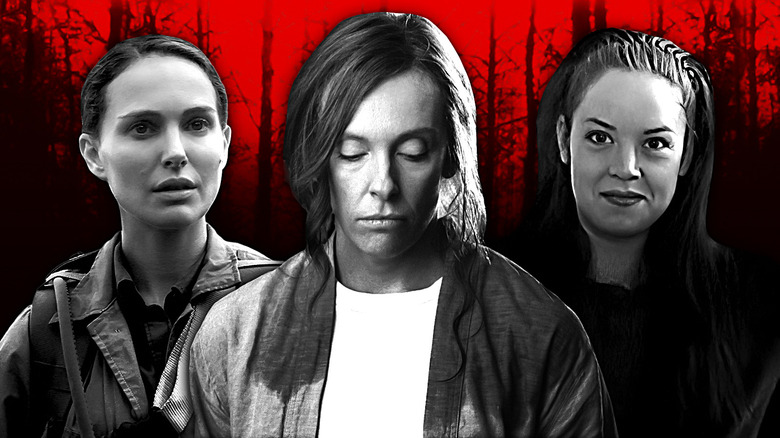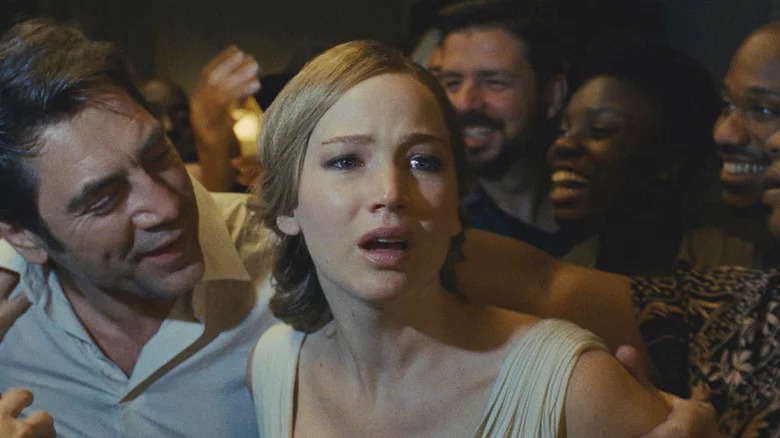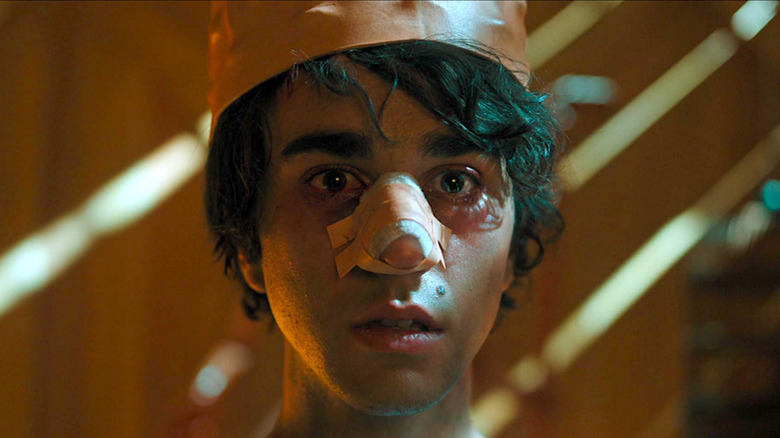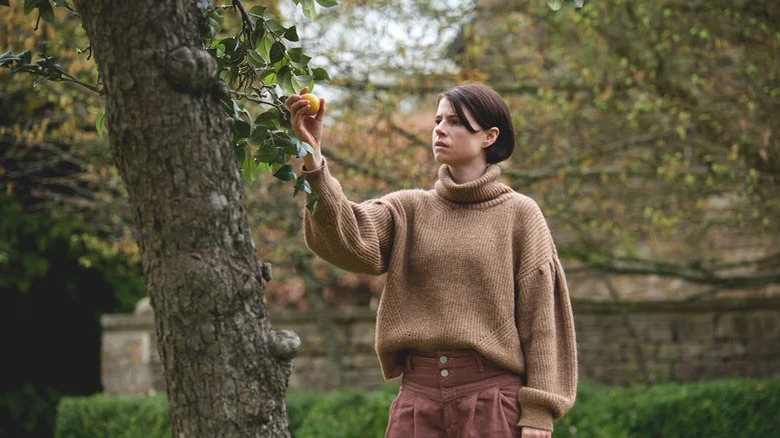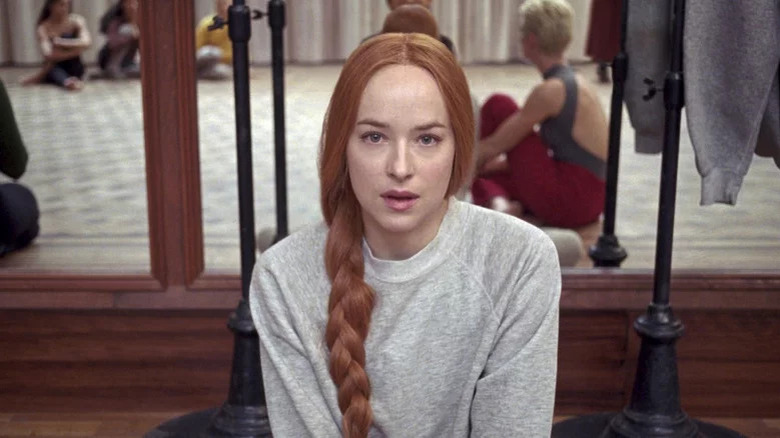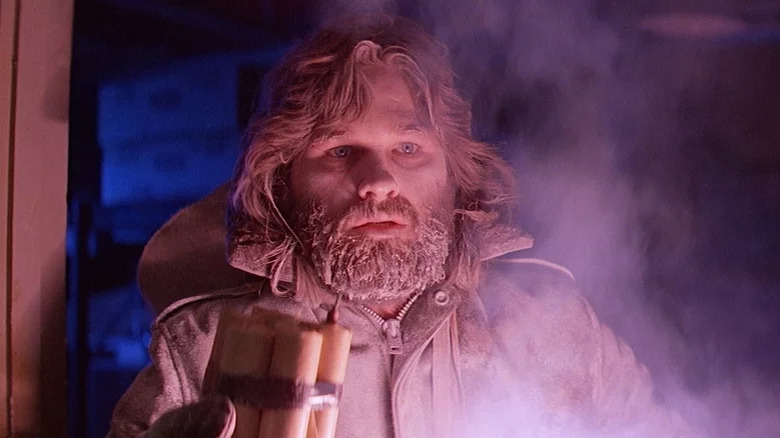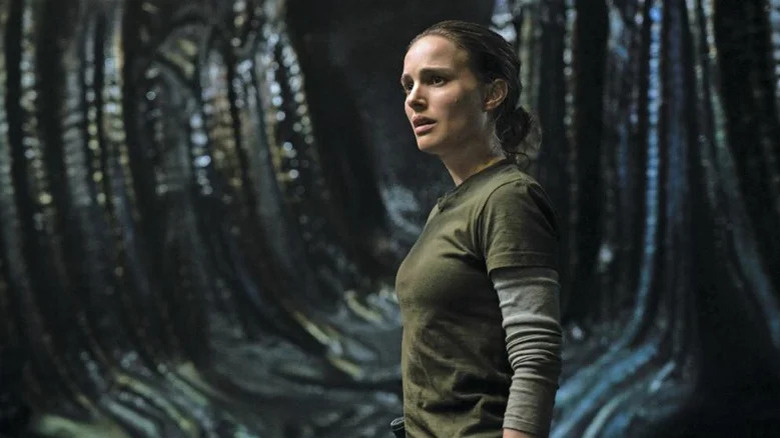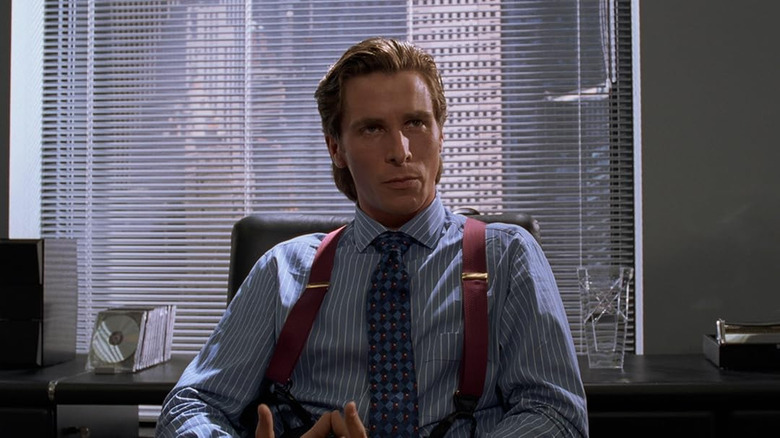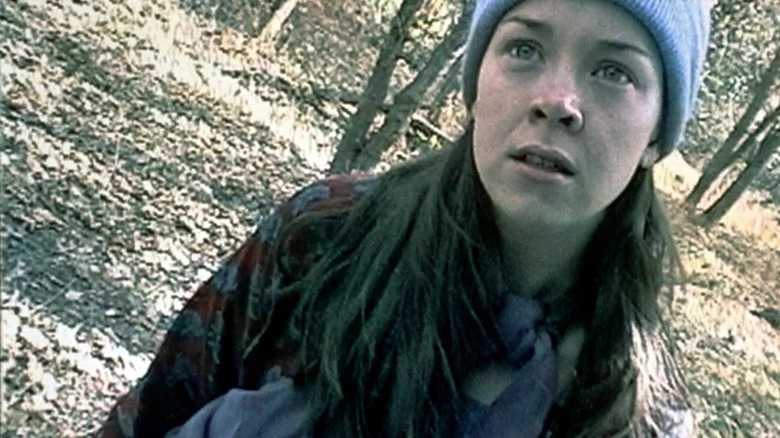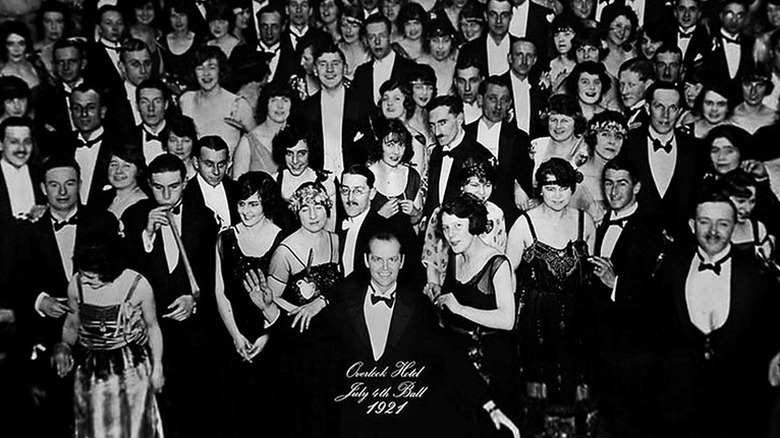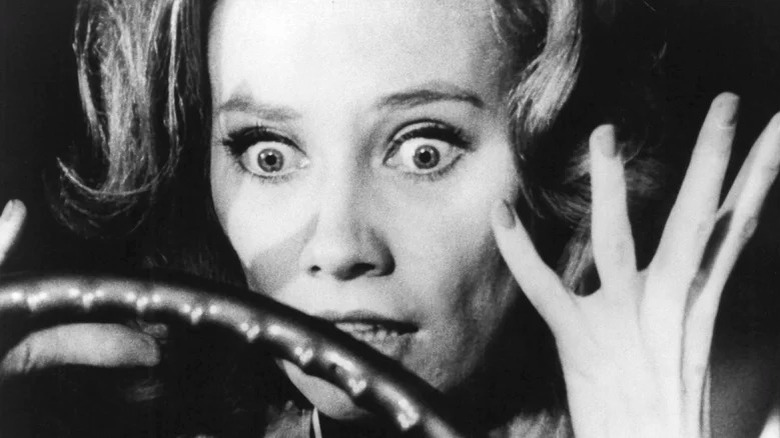Horror Movie Endings That Totally Confused Audiences
Like science fiction and fantasy, films in the horror genre have permission to bend the laws of reality, as long as audiences can still follow the story. No one is too concerned that "Halloween" slasher Michael Myers is somehow invincible and impossible to kill, because that lore was established in the first film and continued throughout the confusing, timeline-erasing franchise. What's not to understand?
On the other hand, plenty of films over the years have left audiences scratching their heads as they exit the theater. Is Leonardo DiCaprio dreaming or awake at the end of "Inception" and does it really matter? Was anything in "Mulholland Drive" real? You might give yourself a headache pondering the answers to those knotty questions.
Horror movies tend to use this kind of uncertainty to frighten viewers, leaving them unsettled and disturbed as the credits roll. This is the worst kind of perplexing ending, because you're not only confused, but terrified as well. Not understanding what happens at the end of a film can be a frustrating experience, too, and that's why we're here to put your mind at ease. The answers you seek for some of the more confusing horror movie endings are contained below, but beware of spoilers.
mother!
Describing the basic plot of Darren Aronofsky's controversial film "mother!" is a difficult task, but we'll do our best. Javier Bardem plays a character known only as Him, who we learn represents God. Jennifer Lawrence plays his wife, known only as mother, and she represents Mother Nature. When Him, a poet, finally publishes an acclaimed work, his fans show up at their house, wreaking havoc and destroying the home.
These fans represent mankind, and the first to show up are Adam (Ed Harris) and Eve (Michelle Pfeiffer), along with their feuding sons, Cain (Domhnall Gleeson) and Abel (Brian Gleeson). The violent chaos escalates in the final act, and the climax occurs when mother gives birth to a baby. While mother wants to keep the baby safe, Him offers the baby up to the houseguests, who kill and then eat the child. Then, mother lights the house on fire, killing everyone but Him, and he pulls a crystal out of her chest to create a new house, and a new, unscathed mother. Huh?
Both Aronofsky and Lawrence have spoken of the film's allegory about the environment and climate change, and that's a good place to start if you want to achieve any sort of enlightenment. While most of the movie is a retelling of the bible — mother's child represents Jesus Christ — Aronofsky also wanted to make a point about humanity's poor treatment of the earth. The end of the film, in which Him creates another mother, indicates that these destructive tendencies are cyclical, which is not exactly a hopeful way to look at mankind's capacity to do better.
Hereditary
Billed as the scariest movie of the year when it premiered in 2018, Ari Aster's "Hereditary" earned its hype. Anyone who's seen the film will never forget the scene where the daughter, Charlie (Milly Shapiro), is decapitated after sticking her head out a car window, nor the scene where Toni Collette crouches on the ceiling in her son's room. So yes, the film's most shocking moments are etched into our brains forever, but do you remember the ending?
At the outset, Hereditary seems to be a film about grief, trauma, and mental illness, but the ending changes everything. We learn that Annie's (Collette) recently deceased mother was part of a cult that worshipped a demon named Paimon. The cult wanted a male host for Paimon to possess, but Annie fought to protect her son, Peter (Alex Wolff), so his sister Charlie got the job. When Peter accidentally decapitates Charlie, he's unable to escape his fate. Annie, possessed by an evil spirit, chases Peter into the attic where he meets the cult and becomes possessed by Paimon. Annie, who has outgrown her usefulness to the cult, decapitates herself with a piano string. The second decapitation suggests that Charlie's death may not have been an accident, and was instead a means for Paimon to possess Peter.
The ending is somewhat controversial, as the focus on Annie's complex inner life and her relationship to grief falls away. Certainly, you could see the conclusion as a metaphor for the patriarchy, as the women in the family are cast aside in favor of a male heir. You can interpret the ending however you'd like, but from a purely literal standpoint, it was Paimon all along.
For more in-depth analysis, read our extensive ending explainer for "Hereditary" over here.
Men
In Alex Garland's "Men," the patriarchy has never looked so disturbing. The film follows Harper (Jessie Buckley), who rents a house in the country following the death of her husband, James (Paapa Essiedu). In flashbacks, we learn that his death was far from ordinary. He was abusive, she threatened to leave him, and then he died by either jumping or falling out a window, landing with a bent ankle and his arm sliced down the middle.
The countryside isn't the respite Harper hopes it will be, as all these strange men keep showing up — men, Harper comes to realize, that all have the same face (the face of Rory Kinnear). These interactions keep getting more and more freaky, as the men imply that Harper is to blame for her husband's behavior, referencing the story of Adam and Eve and the idea of original sin — specifically that women carry the sins of men.
In the final, disgusting sequence, a naked same-faced man becomes pregnant and gives birth to himself over and over. His children crawl towards Harper, giving birth to themselves in the process. Each progeny has the same injuries as her husband, James. Finally, the naked man gives birth to James himself, he tells Harper all he wants is her love.
Once you get over the shock factor of the scene, you'll probably start wondering what it all means. We don't have a decisive answer, as it's up for interpretation, but here's our best guess. The babies giving birth to babies sequence seems to indict James — and men like James — for their childish, ultimately needy behavior. The same-faced men end up subverting the sexist notion of original sin, suggesting instead that men bear the mark of the patriarchy and continue the cycle of violence.
We've also got a more thorough ending explainer for A24's "Men" over here.
Suspiria
In Luca Guadagnino's acclaimed "Suspiria" remake, Dakota Johnson represents a new kind of final girl. In Dario Argento's 1977 film, protagonist Suzy (Jessica Harper) attends a prestigious ballet school in Germany, only to find it's run by a powerful coven of witches that she spends the film trying to outrun. In Guadagnino's film, Susie (Johnson) attends a similar school in Berlin, only everything is not as it seems. The movie introduces the lore of three ancient witches: Mother Suspiriorum, Mother Tenebrarum, and Mother Lachrymarum. In Berlin, the head of the academy, Helena Markos (Tilda Swinton), a powerful witch who claims to be Mother Suspiriorum, looks for a new body to inhabit.
In the film's shocking twist, Mother Markos decapitates former coven leader Madame Blanc (also Tilda Swinton), because she tries to stop the ritual to make Susie the new vessel. Susie reveals herself to be the real Mother Suspiriorum, exposing Mother Markos as a false prophet and killing her and all of her supporters. Susie takes pity on her classmates, suspended in agony, giving them a merciful death, and in the epilogue, visits Josef Klemperer (also Tilda Swinton), erasing his painful memories of the holocaust.
It's unclear how long Susie has been Mother Suspiriorum, but there are clues along the way that something is a little off with Susie. She seems to be drawn to Berlin almost against her will, and she has an inexplicable connection with Madam Blanc. There's something of a moral at the end there, as Susie shows mercy to her friends and to Dr. Klemperer, suggesting that ultimate power doesn't have to be used for evil. But mostly, it's a bloody, mesmerizing hellscape, and you can learn more from Dakota Johnson herself.
The Thing
Though it received middling reviews when it first premiered in 1982, John Carpenter's "The Thing" is now considered a horror classic. The practical effects are unlike anything else captured on screen, the mystery of not knowing who is real and who is a replica is fantastically chilling, there's an awesome flamethrower, and Kurt Russell is there, well, being Kurt Russell.
Paranoia is the name of the game in "The Thing," and as the film progresses, the characters become less and less trusting of each other, not knowing if they are themselves or not. When the film ends, there are only two characters left: MacReady (Russell) and Childs (Keith David). Their arctic base is up in flame and the creature seems to be destroyed, but they're left in subzero temperatures sitting by a fire that will eventually go out. Them freezing to death is a given, but the question remains: is either man infected with The Thing?
The answer to that question has been hotly debated. A popular theory put forth by the film's cinematographer, Dean Cundey, states that there's a specific eye gleam you can see with human characters, which would mean in this case that gleam-less Childs is a fake. ComicBook.com asked Carpenter about Cundey's theory, and he responded: "He has no clue." But does Carpenter have a clue? "Yes, I know. I know who's the Thing and who's not in the very end," he revealed, declining to share the answer. The truth is out there, but Carpenter isn't telling.
Annihilation
Possession and replicas are common themes in horror movies, and such occurrences ask us to question whether there is such a thing as a soul — some internal element within us that remains constant despite changing circumstances. Alex Garland's "Annihilation" takes such questions to the realm of science fiction, to dazzling effect. Natalie Portman plays Lena, a biologist and former soldier who goes into a mysterious zone called the Shimmer to solve the mystery of what happened to her husband, Kane (Oscar Isaac). The Shimmer is full of genetic marvels, altering the DNA of everything within it and creating some pretty terrifying creatures. During the film's climax, Lena travels to a lighthouse where we see the creation of her double. She burns the lighthouse and her double, effectively destroying the Shimmer. But does everything go back to normal?
Probably not. When Lena reunites with her husband at the end of the film, she already suspects he's not the real Kane, because she saw a video of him dying inside the Shimmer. His eyes begin to shimmer, confirming her suspicions. But when Lena hugs him, we get a glimpse of her eyes, too — and they're shimmering just the same.
Does this mean it's Lena's double that escaped the Shimmer, and it's not the original Lena? Not exactly. Lena destroyed her double back at the lighthouse, but she's been in the Shimmer for so long that it's begun to alter her DNA. She's not an entirely new Lena, but she's not the old Lena, either. What that means for her soul or her essence is up for debate, but we've got to admit we're getting chills just thinking about it. Read more about the "Annihilation" ending right here.
American Psycho
Considering its controversial source material, it's a miracle Mary Harron was able to pull off "American Psycho," an adaptation of Brett Easton Ellis' novel of the same name. The film's protagonist, Patrick Bateman (Christian Bale), is a New York investment banker moonlighting as a serial killer. Bateman's entire world is cruel and vapid, to the point where his serial killer behavior doesn't even register as out of the ordinary.
Patrick's lack of distinction from those around him feeds into the film's finale, which has confused many viewers over the years. Bateman kills his loathsome co-worker, Paul Allen (Jared Leto), in his own apartment. He continues to use Allen's apartment as a depository for his many victims, becoming more unhinged as his body count increases. He eventually confesses his crimes to his lawyer, who doesn't believe him, and when he goes to Allen's apartment, he finds it empty.
Was it all in Patrick Bateman's head? That's one interpretation, but it's not exactly what the filmmakers intended. Harron told Charlie Rose that she didn't mean for viewers to conclude that Bateman hallucinated the whole thing, but rather wanted to leave things ambiguous like the book. Indeed, it's more disturbing if Bateman did commit the murders we witness, because it means the world around him is so apathetic that his actions don't matter. As for Allen's cleaned-out apartment, the most logical explanation is that the building's owner realized the unit was empty and got rid of the bodies so he could put it back on the market.
We also have a breakdown of the two most popular interpretations of the "American Psycho" ending for you to read.
The Blair Witch Project
Most famous for its brilliant found footage marketing campaign, "The Blair Witch Project" also contains an ending that has vexed audiences for years. In case you've forgotten, the film follows three college students, Josh (Joshua Leonard), Heather (Heather Donahue), and Mike (Michael C. Williams), who are on a mission to find the legendary Blair Witch in the forest of Maryland. When Josh disappears, Heather and Mike set out to find him after listening to his anguished screams all night.
They enter a decrepit house with two cameras, and things get freaky. We start with Mike's camera, but he quickly gets knocked out. The perspective switches to Heather's camera, which glides around the house as she screams. The camera turns to show Mike standing in the corner as Heather continues to yell before being knocked out herself.
So what really happened? There are many theories, but we'll give you two of the most popular. One theory surmises that when the film switches from Mike to Heather's perspective, it's actually the Blair Witch holding the camera, which would explain the otherworldly way it moves. The other theory posits that the person holding the camera is Josh, who is under the Blair Witch's spell. Mike and Heather's attacks — with Mike facing the corner — mirror how local murderer Rustin Parr killed his victims, supposedly at the bidding of the Blair Witch. There are several other theories out there if neither of those strike your fancy, but part of the film's brilliance is that it leaves plenty to the imagination.
There's plenty more to learn about "The Blair Witch Project" ending over here.
The Shining
Horror legend Stephen King hasn't been shy about sharing his distaste for Stanley Kubrick's masterpiece, and the film's ambiguous ending is one of the several ways the movie departs from its source material. King's animosity towards the film notwithstanding, there's one element of the conclusion that has long troubled audiences.
In the movie, Jack (Jack Nicholson) takes a job as the caretaker of the vacant Overlook hotel, bringing his wife Wendy (Shelley Duvall) and son Danny (Danny Lloyd) along. Jack loses his mind, and Wendy and Danny escape, leaving Jack freezing in the snow. But it's during the final scene that things get surreal. We see a photo in the Overlook that depicts Jack and a group of guests at a ball — and it's dated 1921.
What does it mean? Earlier in the film, the hotel's previous caretaker, Delbert Grady (Philip Stone), gives Jack an ominous clue to the ending. "You are the caretaker. You've always been the caretaker. I should know, sir... I've always been here." The Overlook Hotel contains a dangerous amount of supernatural power, and it's filled with spirits who feast on the souls of unsuspecting victims. The hotel tried to influence Jack — vulnerable because of his struggles with alcoholism — to kill his family as Grady did before him. Though Wendy and Danny survive, Jack is now a part of the hotel — both in the present and in the past.
To dig into the mystery even more, we've got a full ending explainer for "The Shining" too.
Carnival of Souls
When "Carnival of Souls" first premiered in 1962, no one had much to say about it. Decades later, the film played on late-night television, was restored in 1989, and returned to theaters that same year. Today, it's something of a cult classic, and it serves as an early example of some now canonical horror tropes.
The film follows Mary Henry, a young woman whose car crashes into a river. The other passengers perish, but Mary somehow survives — or so we think. After stumbling out of the river, Mary gets on with her life, but something's not quite right. A ghoulish figure (played by director Herk Harvey) keeps following her around, and she seems to flicker in and out of reality, invisible to others. The ghoul eventually leads her to an abandoned carnival ground, where she partakes in a sort of dance of death — twirling with other spectral figures in a dusty old ballroom. The final twist shows the car being dragged out of the river, with Mary dead inside.
Was she dead all along, like "The Sixth Sense" twist for Bruce Willis? That's a common interpretation of the film, yes. The creepy man following her is Death himself, and his job is to lead her to the afterlife, or at least force her to accept her death. This theory suggests that the other people she interacts with are dead as well. Another explanation states that the entire film is a daydream Mary has in the seconds before she plummets to her death. Others believe she does survive but the ghouls force her back into the car, implying that death is a fate she can't escape.
